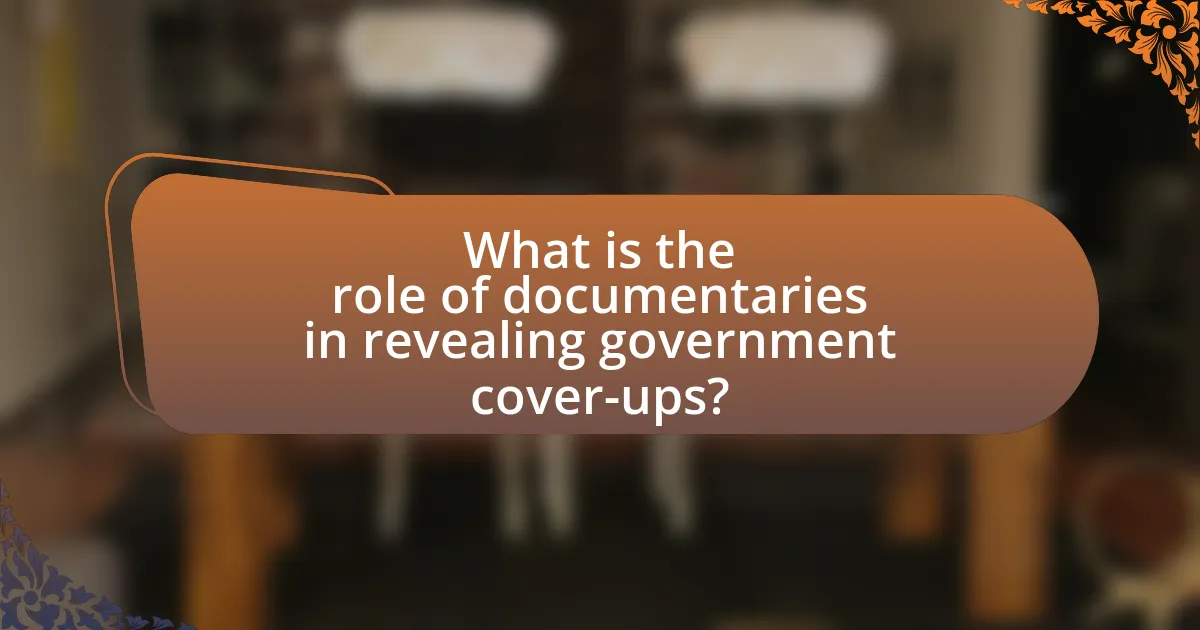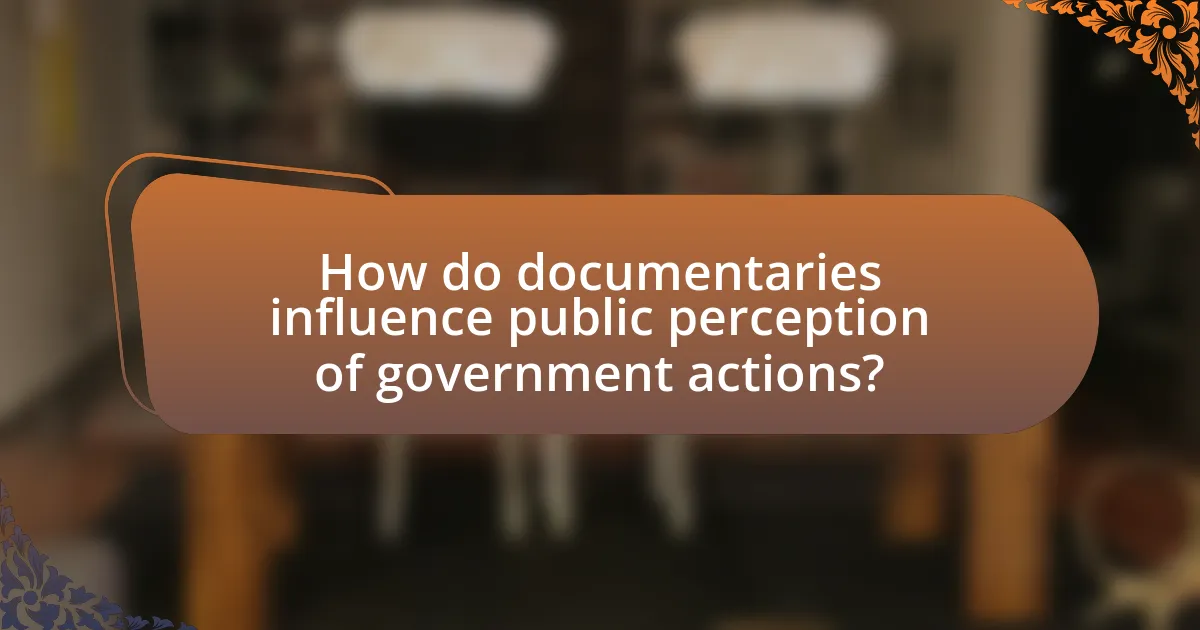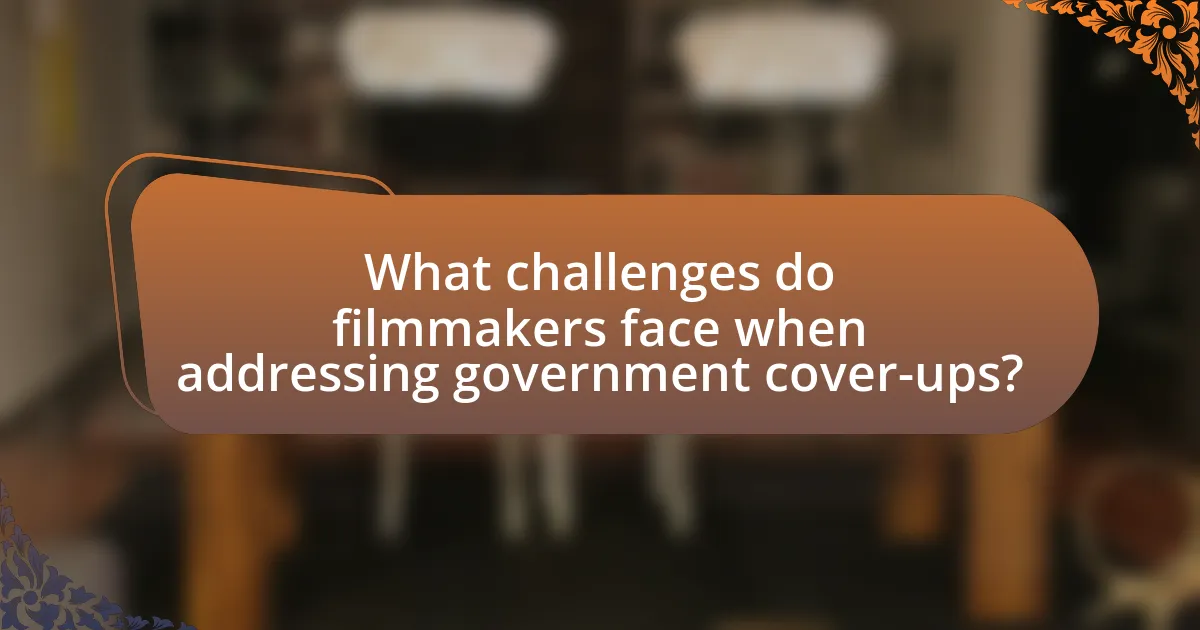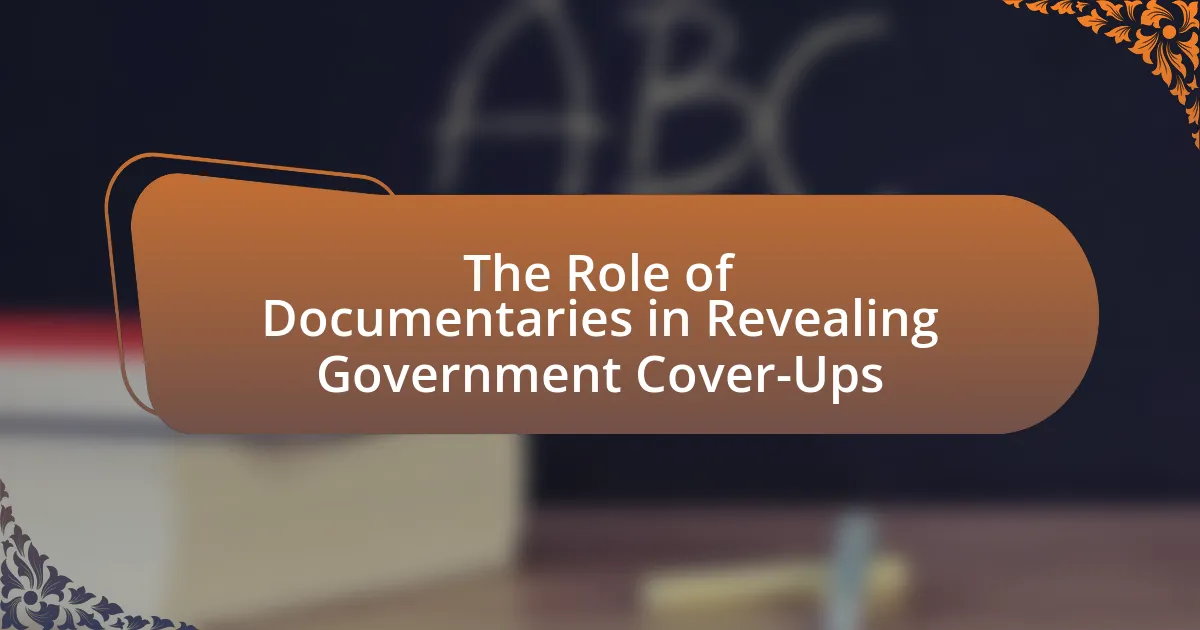Documentaries serve a vital role in uncovering government cover-ups by investigating and presenting evidence that challenges official narratives. They utilize techniques such as interviews, archival footage, and expert analysis to expose hidden truths, as exemplified by films like “The Fog of War” and “Citizenfour.” These documentaries not only inform the public but also mobilize opinion and promote accountability, highlighting the emotional and psychological impacts on viewers. Additionally, filmmakers face challenges such as censorship and legal pressures while navigating ethical considerations in their storytelling. The article explores the effectiveness of documentaries in revealing government actions, the techniques employed by filmmakers, and the historical significance of notable films in promoting transparency and social justice.

What is the role of documentaries in revealing government cover-ups?
Documentaries play a crucial role in revealing government cover-ups by investigating and presenting evidence that challenges official narratives. They often utilize interviews, archival footage, and expert analysis to expose hidden truths, as seen in films like “The Fog of War,” which examines U.S. military decisions through the lens of former Secretary of Defense Robert S. McNamara. Such documentaries can mobilize public opinion and prompt governmental accountability, as demonstrated by “Citizenfour,” which brought to light Edward Snowden’s revelations about NSA surveillance practices. By providing a platform for whistleblowers and victims, documentaries serve as powerful tools for transparency and social justice.
How do documentaries expose hidden truths about government actions?
Documentaries expose hidden truths about government actions by investigating and presenting evidence that challenges official narratives. Through in-depth research, interviews with whistleblowers, and the analysis of declassified documents, filmmakers uncover discrepancies and misconduct that may be overlooked or suppressed by authorities. For example, the documentary “The Fog of War” reveals the complexities and moral dilemmas of U.S. military decisions, highlighting how government actions can lead to unintended consequences. This type of critical examination not only informs the public but also holds governments accountable, as seen in the impact of documentaries like “Citizenfour,” which brought attention to Edward Snowden’s revelations about mass surveillance.
What techniques do filmmakers use to uncover government cover-ups?
Filmmakers use investigative research, interviews, archival footage, and expert analysis to uncover government cover-ups. Investigative research involves scrutinizing public records, whistleblower accounts, and declassified documents to gather evidence. Interviews with insiders, victims, and experts provide personal testimonies and insights that can reveal hidden truths. Archival footage serves to contextualize events and substantiate claims, while expert analysis helps interpret complex information and validate findings. These techniques have been effectively employed in documentaries like “The Fog of War,” which examines U.S. military decisions, and “Citizenfour,” which reveals NSA surveillance practices, demonstrating their efficacy in exposing government malfeasance.
How do interviews and testimonies contribute to the narrative?
Interviews and testimonies significantly enhance the narrative by providing firsthand accounts that add depth and authenticity to the story. These personal experiences often reveal critical insights and perspectives that official sources may overlook or omit, thereby enriching the overall understanding of events. For instance, in documentaries addressing government cover-ups, interviews with whistleblowers or affected individuals can expose hidden truths and challenge the official narrative, as seen in films like “The Fog of War,” where Robert S. McNamara shares his experiences related to the Vietnam War, offering a personal lens on historical events. This direct engagement with individuals involved allows the audience to connect emotionally and intellectually, making the narrative more compelling and credible.
Why are documentaries an effective medium for this purpose?
Documentaries are an effective medium for revealing government cover-ups because they combine visual storytelling with factual evidence, making complex issues accessible to a broad audience. This format allows filmmakers to present in-depth research, interviews, and archival footage that can substantiate claims of misconduct or secrecy. For instance, the documentary “The Fog of War” uses Robert S. McNamara’s reflections to expose the complexities and moral ambiguities of U.S. military decisions, illustrating how personal narratives can highlight systemic issues. Additionally, documentaries often engage viewers emotionally, prompting critical thinking and encouraging public discourse, which can lead to increased scrutiny of government actions.
What emotional and psychological impacts do documentaries have on viewers?
Documentaries significantly impact viewers emotionally and psychologically by evoking strong feelings such as empathy, anger, and motivation for social change. These films often present real-life stories and injustices, which can lead to heightened awareness and emotional engagement with the subject matter. For instance, studies have shown that documentaries addressing social issues can increase viewers’ empathy levels, prompting them to take action or change their perspectives. Research published in the journal “Media Psychology” indicates that emotionally charged content in documentaries can lead to increased viewer engagement and a greater likelihood of discussing the issues presented, thereby influencing public opinion and behavior.
How does the visual storytelling format enhance the message?
The visual storytelling format enhances the message by providing a compelling and immersive way to convey complex narratives. This format engages viewers emotionally and cognitively, making the information more relatable and memorable. For instance, documentaries that utilize visuals, such as archival footage or personal testimonies, can illustrate the impact of government cover-ups more effectively than text alone. Research indicates that visuals can increase retention rates by up to 65%, demonstrating their power in reinforcing the message. By combining imagery with narrative, visual storytelling not only captures attention but also fosters a deeper understanding of the subject matter, ultimately leading to greater awareness and advocacy regarding issues like government transparency.
What historical examples illustrate the impact of documentaries on government transparency?
Documentaries have historically influenced government transparency, notably through films like “The Fog of War” and “Inside Job.” “The Fog of War,” directed by Errol Morris, explores the complexities of war and U.S. foreign policy through the lens of former Secretary of Defense Robert S. McNamara, revealing critical insights into decision-making processes during the Vietnam War. This documentary prompted public discourse on governmental accountability and the ethical implications of military actions.
Similarly, “Inside Job,” directed by Charles Ferguson, investigates the 2008 financial crisis, exposing systemic corruption within financial institutions and regulatory bodies. The film’s detailed analysis of the events leading to the crisis and the lack of accountability among key players led to increased public scrutiny and calls for regulatory reform. Both documentaries exemplify how visual storytelling can unveil hidden truths, fostering a demand for greater transparency in government actions.
Which notable documentaries have successfully revealed cover-ups?
Notable documentaries that have successfully revealed cover-ups include “The Fog of War,” which exposes the complexities of U.S. military decisions during the Vietnam War, and “Citizenfour,” which details Edward Snowden’s revelations about NSA surveillance practices. “The Act of Killing” confronts the Indonesian genocide and the complicity of the government in covering up these atrocities. Additionally, “Inside Job” investigates the 2008 financial crisis, highlighting the systemic corruption and regulatory failures that contributed to the economic collapse. Each of these documentaries provides critical insights and evidence that challenge official narratives and expose hidden truths.
What were the outcomes of these revelations for the government and society?
The outcomes of these revelations for the government included increased scrutiny and accountability, while society experienced heightened awareness and activism. Documentaries exposing government cover-ups often led to public outcry, prompting legislative changes and reforms aimed at transparency. For instance, the release of the Pentagon Papers in 1971 resulted in significant shifts in public trust towards the government and catalyzed anti-war movements. Such revelations have historically influenced policy decisions and fostered a more informed citizenry, as seen in the aftermath of the Watergate scandal, which led to the resignation of President Nixon and the establishment of more stringent checks on executive power.

How do documentaries influence public perception of government actions?
Documentaries significantly influence public perception of government actions by providing in-depth analysis and visual storytelling that highlight issues often overlooked by mainstream media. For instance, documentaries like “The Fog of War” reveal the complexities of military decisions, prompting viewers to question governmental narratives. Research indicates that documentaries can shift public opinion; a study published in the Journal of Communication found that exposure to documentary films increased awareness and concern about social issues, including government accountability. This effect is amplified when documentaries present compelling evidence, such as leaked documents or firsthand accounts, which can challenge official government statements and foster skepticism among viewers.
What role does audience engagement play in shaping opinions?
Audience engagement plays a crucial role in shaping opinions by fostering a connection between the content and the viewers, which enhances the impact of the message. When audiences actively participate through discussions, social media interactions, or feedback, they contribute to a collective understanding and interpretation of the documentary’s themes. Research indicates that documentaries with high audience engagement often lead to increased awareness and shifts in public perception, as seen in the case of “The Act of Killing,” where viewer discussions significantly influenced opinions on historical atrocities. This interaction not only reinforces the documentary’s narrative but also encourages viewers to critically analyze and share their perspectives, further amplifying the documentary’s reach and influence on societal views.
How do documentaries create a sense of urgency around issues?
Documentaries create a sense of urgency around issues by presenting compelling narratives that highlight the immediacy and severity of the problems being addressed. They often utilize emotional storytelling, real-life testimonials, and stark visuals to engage viewers, making the issues feel personal and pressing. For instance, documentaries like “The Act of Killing” and “13th” effectively illustrate systemic injustices, prompting audiences to recognize the need for immediate action. Additionally, statistics and expert interviews are frequently incorporated to provide factual backing, reinforcing the urgency of the issues at hand. This combination of emotional engagement and factual evidence compels viewers to confront the realities of the situations depicted, fostering a sense of responsibility to act.
What feedback mechanisms exist between documentaries and public discourse?
Documentaries influence public discourse through several feedback mechanisms, including audience engagement, social media discussions, and policy advocacy. Audience engagement occurs when viewers share their reactions and insights, prompting broader conversations about the documentary’s subject matter. Social media platforms amplify these discussions, allowing for real-time interactions and the dissemination of information, which can lead to increased public awareness and mobilization around issues highlighted in the documentaries. Additionally, documentaries often inspire advocacy efforts, where viewers may push for policy changes or demand accountability from government entities, as seen in cases like “The Fog of War,” which spurred discussions on U.S. military policy. These mechanisms demonstrate how documentaries not only reflect but also shape public discourse, creating a dynamic interplay between media and societal issues.
How do documentaries challenge mainstream narratives?
Documentaries challenge mainstream narratives by presenting alternative perspectives and uncovering hidden truths that are often overlooked or suppressed by traditional media. For instance, documentaries like “The Fog of War” reveal the complexities of war and government decisions, providing insights that contradict official narratives. Additionally, films such as “Citizenfour” expose government surveillance practices, directly challenging the narratives promoted by authorities regarding privacy and security. These documentaries utilize interviews, archival footage, and investigative research to substantiate their claims, thereby fostering critical discourse and encouraging viewers to question accepted narratives.
What strategies do filmmakers use to present alternative viewpoints?
Filmmakers use various strategies to present alternative viewpoints, including interviews with diverse subjects, archival footage, and narrative framing. By incorporating interviews with individuals who have differing perspectives, filmmakers can showcase a range of opinions and experiences, thereby enriching the narrative. Archival footage serves as a powerful tool to provide historical context and contrast prevailing narratives, allowing viewers to see events from multiple angles. Additionally, narrative framing, which involves the way a story is structured and presented, can influence audience perception by emphasizing certain themes or viewpoints over others. These strategies are evident in documentaries that challenge mainstream narratives, such as “The Fog of War,” which presents alternative perspectives on war through the reflections of former U.S. Secretary of Defense Robert S. McNamara.
How do documentaries encourage critical thinking among viewers?
Documentaries encourage critical thinking among viewers by presenting factual information and diverse perspectives that challenge preconceived notions. They often include interviews with experts, archival footage, and data analysis, prompting viewers to question the narratives presented by mainstream media or government sources. For instance, documentaries like “The Fog of War” provide insights into historical events through the lens of personal experiences, encouraging audiences to analyze the complexities of war and decision-making. This engagement with multifaceted viewpoints fosters a deeper understanding of issues, leading viewers to critically evaluate the information they consume and the motivations behind it.

What challenges do filmmakers face when addressing government cover-ups?
Filmmakers face significant challenges when addressing government cover-ups, primarily due to censorship, legal repercussions, and access to information. Censorship can manifest through governmental pressure or self-censorship, where filmmakers may alter content to avoid backlash. Legal repercussions include potential lawsuits or criminal charges for defamation or revealing classified information, which can deter filmmakers from pursuing sensitive topics. Additionally, access to information is often restricted, as government agencies may withhold documents or data, making it difficult for filmmakers to substantiate their claims. For instance, the documentary “Citizenfour,” which exposed NSA surveillance, faced hurdles in obtaining documents and interviews, highlighting the obstacles filmmakers encounter in revealing government misconduct.
How do legal and political pressures affect documentary production?
Legal and political pressures significantly influence documentary production by shaping the content, access to information, and the overall feasibility of projects. Filmmakers often face legal challenges such as defamation lawsuits, copyright issues, and censorship, which can restrict their ability to present certain narratives or expose government actions. For instance, the documentary “The Fog of War,” which examines U.S. military decisions, faced scrutiny and potential legal repercussions due to its critical portrayal of government officials. Additionally, political pressures can lead to self-censorship, where filmmakers avoid controversial topics to prevent backlash from authorities or funding sources. This dynamic can limit the scope of documentaries that aim to reveal government cover-ups, as filmmakers may prioritize safety and funding stability over journalistic integrity.
What are common legal obstacles encountered by filmmakers?
Common legal obstacles encountered by filmmakers include copyright infringement, defamation, and issues related to licensing and permits. Copyright infringement arises when filmmakers use protected material without permission, which can lead to lawsuits and financial penalties. Defamation occurs when a film portrays individuals or entities in a false light, potentially resulting in legal action for damages. Additionally, filmmakers often face challenges in obtaining necessary licenses and permits for filming in specific locations, which can delay production and increase costs. These legal issues are critical for filmmakers to navigate to ensure compliance and protect their projects.
How do filmmakers navigate censorship and pushback from authorities?
Filmmakers navigate censorship and pushback from authorities by employing strategies such as creative storytelling, legal advocacy, and collaboration with international organizations. Creative storytelling allows filmmakers to present sensitive topics in a way that circumvents direct confrontation with censorship laws, often using allegory or metaphor to convey their messages. Legal advocacy involves understanding and utilizing existing laws to protect their work, as seen in cases where filmmakers have successfully challenged censorship in court, such as the 2012 case of “The Act of Killing,” which faced scrutiny in Indonesia but ultimately gained international acclaim. Collaboration with international organizations, like the International Documentary Association, provides filmmakers with resources and support to amplify their voices and protect their rights against oppressive regimes. These methods demonstrate how filmmakers can effectively address and overcome the challenges posed by censorship and governmental pushback.
What ethical considerations arise in the production of these documentaries?
Ethical considerations in the production of documentaries revealing government cover-ups include issues of consent, representation, and accuracy. Producers must ensure that participants provide informed consent, particularly when sensitive topics are involved, to respect their autonomy and rights. Additionally, the representation of subjects must be fair and truthful, avoiding manipulation or sensationalism that could distort the narrative. Accuracy is crucial, as documentaries should rely on verified information to maintain credibility and avoid spreading misinformation, which can have significant societal implications. For instance, the documentary “The Fog of War” faced scrutiny regarding the portrayal of Robert S. McNamara, highlighting the need for ethical responsibility in presenting complex historical narratives.
How do filmmakers balance truth-telling with responsible storytelling?
Filmmakers balance truth-telling with responsible storytelling by adhering to ethical guidelines and prioritizing accuracy while considering the potential impact of their narratives. They often conduct thorough research, consult experts, and utilize primary sources to ensure factual integrity, as seen in documentaries like “The Fog of War,” which presents complex historical truths while addressing moral implications. This approach allows filmmakers to present nuanced perspectives that inform audiences without sensationalizing or misrepresenting sensitive topics, thereby fostering a responsible dialogue around government actions and cover-ups.
What responsibilities do filmmakers have towards their subjects and audiences?
Filmmakers have the responsibility to portray their subjects accurately and ethically while ensuring that their audiences receive truthful and informative content. This includes obtaining informed consent from subjects, representing their stories with integrity, and avoiding exploitation. For instance, the documentary “The Act of Killing” faced criticism for its portrayal of Indonesian death squad leaders, highlighting the ethical dilemmas filmmakers encounter in balancing artistic expression with moral obligations. Additionally, filmmakers must consider the impact of their work on public perception and discourse, as documentaries can shape societal understanding of critical issues, such as government accountability.
What practical tips can aspiring filmmakers follow to effectively reveal government cover-ups?
Aspiring filmmakers can effectively reveal government cover-ups by conducting thorough research and utilizing investigative techniques. This involves gathering credible sources, such as whistleblower testimonies and declassified documents, to substantiate claims. For instance, the Pentagon Papers case demonstrated how leaked documents exposed government deception regarding the Vietnam War, highlighting the importance of sourcing reliable information. Filmmakers should also engage with affected communities to capture personal narratives, which can humanize the issue and provide compelling evidence. Additionally, employing visual storytelling techniques, such as juxtaposing official statements with real-life consequences, can enhance the impact of the documentary. By combining rigorous research, community engagement, and effective storytelling, filmmakers can create powerful narratives that challenge government transparency.
How can filmmakers build trust with sources and subjects?
Filmmakers can build trust with sources and subjects by demonstrating transparency and integrity throughout the filmmaking process. Establishing open communication, clearly outlining intentions, and respecting the privacy and concerns of participants fosters a sense of security. Research indicates that trust is significantly enhanced when filmmakers engage in active listening and provide assurances regarding how the information will be used, as seen in the documentary “The Act of Killing,” where filmmakers built rapport with former Indonesian death squad leaders by allowing them to express their narratives. This approach not only cultivates trust but also encourages subjects to share more candidly, ultimately enriching the documentary’s authenticity and depth.
What resources are available for researching government actions and cover-ups?
Resources for researching government actions and cover-ups include government databases, investigative journalism platforms, and academic publications. Government databases such as the Freedom of Information Act (FOIA) allow citizens to request access to federal agency records, providing primary source material for research. Investigative journalism platforms like ProPublica and The Center for Investigative Reporting publish in-depth reports on government misconduct, often revealing cover-ups through thorough investigations. Academic publications, including journals like the Journal of Political Science and the Journal of Communication, offer peer-reviewed articles that analyze government actions and transparency issues, providing a scholarly perspective on the topic. These resources collectively enhance the understanding of government actions and potential cover-ups.
